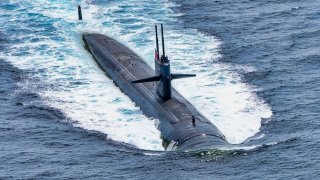The U.S. Military's Great Achilles Heel: A Shipyard Crisis
Despite the political edicts from Washington calling for a 355 ship Navy; irrespective of whatever the Navy may tell Congress it needs, so long as these fundamental problems persist in the shipbuilding sector, the US will never achieve its ambitious goal of an expanded Navy that can meet new challenges.
The United States cannot build enough ships to meet peacetime demand. Specifically, US shipyards are struggling to produce the submarines the United States Navy needs to meet its global mission requirements. This is not a new problem. It has dogged America’s shipyards for decades.
When I worked in Congress a decade ago, it was a perennial point of contention among my colleagues who worked on the Armed Services and Foreign Affairs Committees. Yet, the private sector or the US government has done absolutely nothing to change this paradigm.
And now, as a third world war stalks us all like an alligator does its unsuspecting prey in the swamp, readying to lunge, there is still little discussion about the need to increase production. This, as the Ukraine War (as well as the national lockdowns from COVID-19) laid bare the inherent brittleness of America’s industrial base and its attendant supply chains.
Despite having experienced these problems, the shipbuilding industry as well as the federal government apparently didn’t get the message. Now, America’s enemies—notably China, with its massive, modern, and expanding industrial base—are outpacing the Americans with their own shipbuilding.
At some point, the United States, which has rested on its laurels for too long since the end of the Cold War, will have to pay the Pied Piper.
U.S. Shipbuilding: Stuck in the Past
The US shipbuilding industry has been kept mostly insulated from the rest of the world for centuries. Rightly fearing the prospect of becoming dependent on foreign actors who might either be conquered in war or who might become a threat (as China has), Washington has correctly refused to allow for its shipbuilding to be done outside of the country.
For some Free Traders, this is the source of the problem. But that’s not accurate. After all, the US was the “arsenal of democracy” and its shipbuilding systems were still insulated here in the United States. That insulated industrial base won the Second World War for America and its Allies.
So, what happened between then and now?
It’s first important to understand what a modern, productive shipyard looks like and what America’s today appears as. Austin Vernon has written an excellent breakdown on what makes shipyards successful or failures. Successful shipyards, according to Vernon, include the following:
Block-style construction:
-Group techniques,
-Tight tolerances and testing,
-Elimination of outfitting,
Sufficient scale/Agglomeration
-Extreme attention to detail.
How to Fix America’s Shipyards: Remove Politics
Vernon identifies Japanese and South Korean shipyards as embodying this ethos. American shipyards, on the other hand, are on the struggle boat. Of course, the US uses block-style construction and grouping but other aspects of successful shipyards are not yet employed.
For example:
The main thrust of the problems redounds to politics. Essentially, Congress likes to fund projects that require jobs to spread out across the country, in their various districts, so they can claim to have brought new jobs to their congressional districts. This creates stunning inefficiencies. Because of this, American shipyards are more manpower intensive than are more productive foreign shipyards.
There is a stunning lack of investment in modern tooling and organization. Lack of agglomeration/clusters means that shipyards cannot be concentrated in one locale. Everything must be spread out.
Therefore, labor and suppliers are limited.
The Pentagon’s infamous, sclerotic acquisitions process has also severely hampered American shipyards. Only a handful of vendors can even compete for contracts with the US Navy, imposing extra costs and critical delays due to excessive bureaucracy. Then there is a lack of scale which Vernon asserts is the leading cause behind the decline of America’s shipyards. We don’t build enough warships.
The reason we don’t build enough ships, though, is because of all the aforementioned bureaucratic and political hurdles that get in the way of shipyards producing the weapons of war that we require.
Here’s What Happens If We Don’t Fix Things
All this has had a cumulative effect of ensuring that the United States Navy has a small—and shrinking fleet. Despite the political edicts from Washington calling for a 355 ship Navy; irrespective of whatever the Navy may tell Congress it needs, so long as these fundamental problems persist in the shipbuilding sector, the US will never achieve its ambitious goal of an expanded Navy that can meet new challenges.
And the lack of submarines could be decisive in any conflict with China. This is especially the case, considering that Chinese anti-access/area denial (A2/AD) will likely do unbelievable amounts of damage to America’s surface fleet at the onset of a direct war. This will leave only the ailing submarine fleet as a possible option for responding to Chinese aggression in the Indo-Pacific.
There is an insufficient number of submarines available, and the shipyards cannot produce enough of them to replace any subs lost in combat in a timely manner.
That, dear readers, is why the US may likely lose a direct war with a rival like China. Not because China is more advanced or better trained. But because their industrial base is primed for war while ours is still stuck in the 1990s.
About the Author
Brandon J. Weichert, a National Interest national security analyst, is a former Congressional staffer and geopolitical analyst who is a contributor at The Washington Times, the Asia Times, and The-Pipeline. He is the author of Winning Space: How America Remains a Superpower, Biohacked: China’s Race to Control Life, and The Shadow War: Iran’s Quest for Supremacy. His next book, A Disaster of Our Own Making: How the West Lost Ukraine, is due October 22 from Encounter Books. Weichert can be followed via Twitter @WeTheBrandon.


